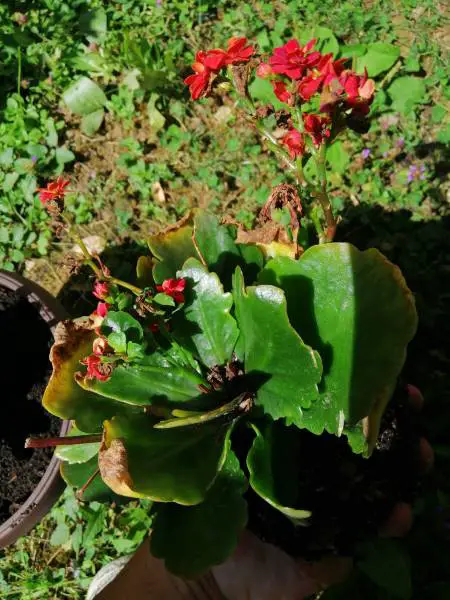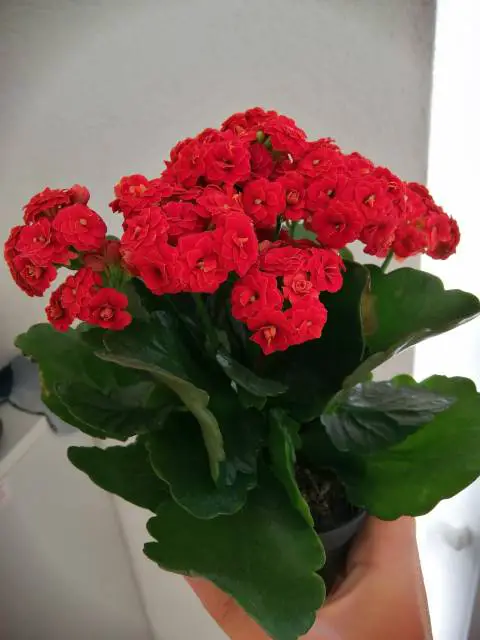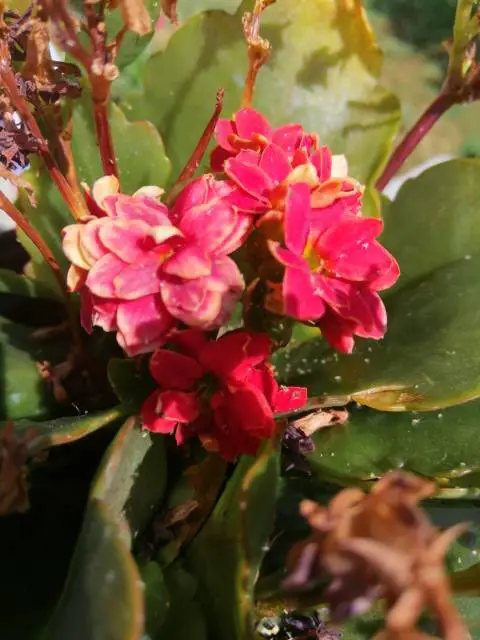Kalanchoe Blossfeldiana, also known as Flaming Katy is a flowering perennial succulent. Native to Madagascar the succulent belongs to the family Crassulaceae.
Sometimes there is nothing wrong with the succulent and it just passes through a natural process like shedding of leaves during winter. Other times the problem could be that the succulent has been overwatered, underwatered or facing a lack of sunlight. If you don’t know how to care for your Flaming Katy, you can often experience some troubles growing them. Keep a check on your plants and resolve the problems as soon as they appear.


Lets discuss some Kalanchoe Blosffediana states and see if is actually dying or just going through a natural process. I will also go through ways to recover Kalanchoe.
Keep a check on watering
Flaming Katy is a drought-tolerant succulent and requires moderate watering. Keep a check on how frequently you are watering your succulents. Record the dates of watering on a page or diary. Or you can use a Succulent Track App to track your group of plants. The app also helps you to keep a record of many other things about your Kalanchoe blossfeldiana like watering, repotting, treatment of insects and pictures, etc.
a) Overwatering
Flaming Katy does not like to be watered like your other houseplants. It has different watering needs and likes to be watered less often. It handles the drought well and can get along with very little water in well-draining potting soil. They should be watered until the soil becomes moist but never make the soil overwatered or oversaturated. Flaming Katy hates growing in muddy or oversaturated soil.
If your Flaming Katy leaves appear transparent and yellow and feel soggy or mushy to the touch, it’s a sign that they are suffering from overwatering.
As an early sign of overwatering, you will experience that the leaves will fall off easily with just a little touch. If you continue overwatering you will notice your Flaming Katy stem will turn black with mushy spots on the stem and leaves. Overwatering is the most detrimental problem that can cause your succulent to die soon.
How to save an overwatered Flaming Katy?
The best thing is to avoid overwatering and make sure the soil dries out completely before the next watering.
If you are lucky enough to observe the early symptoms of overwatering on your Flaming Katy, you must reduce the watering frequency. Water your succulents less frequently and use containers with good drainage holes. At the early stage, it will be easier to recover your succulents from overwatering.
If you feel that your Flaming Katy is about to die and will not be able to recover you should take cuttings of the alive parts of stems and leaves and propagate all new plants from them.
My article on Blossfeldiana Propagation.
b) Underwatering
Though overwatering is the most common problem of Kalanchoe blossfeldiana, they are sensitive to underwatering. They can tolerate a period of drought for a considerably long time but if left un-watered for long at a certain point of time they will start showing stress due to water shortage.
The leaves at the top of your Flaming Katy plant will appear wrinkled and wilted. The leaves will also appear brittle and crispy. Later the leaves turn brown and start drooping. At an advanced stage, the succulent will be completely wilted and ultimately die.
How to save underwatered Flaming Katy?
I have experienced with my Flaming Katy that it is easier to revive an underwatered succulent than an overwatered one. If your Flaming Katy has started to wrinkle it will be recovered by increasing the watering frequency. But if your Flaming Katy has completely wilted, sadly it will not be able to recover.
To recover the plants at an early stage of overwatering, water them well to soak the soil completely. Let the soil drain well and don’t apply the next water until the top couple of inches of the soil dry out completely.
Make sure to check my post on how to care for Kalanchoe blossfeldiana.
Check if you are giving enough light
Kalanchoe blossfeldiana needs plenty of sunlight to grow healthy. Low light exposure will make your succulents leggy and stretched out. The stem will stretch out and grow at an unusual length in search of light this phenomenon is termed “etiolation”. If you continue to ignore your Flaming Katy succulents, they will stretch out to the point that they will ultimately collapse. On the other hand, too much exposure to bright intense sunlight can also cause the burning of stems and leaves. The damage from sunburn is permanent and the leaves will not be able to recover.

How to save a Flaming Katy dying due to lack or excess of sunlight?
Move your Flaming Katy under bright indirect sunlight. Indoor succulents should be moved near a window where plenty of sunlight can reach them. In indoor conditions, artificial grow lights can also work. To avoid the damage due to excessive exposure to sunlight keep your plants at a shady place where they get filtered sunlight. Do not place them under the direct sun particularly during the summer months when the sun is too hot.
Poorly draining containers and potting soil
Kalanchoe blossfeldiana likes to grow in well-draining soil. Poorly draining soils and containers retain a greater amount of water with poor air circulation. It does not let the roots breathe properly. Lack of proper drainage will lead to water build-up in the soil that will ultimately cause decay and disintegration of roots.
Transfer your Flaming Katy succulents in a well-draining soil that is a mix of 60% peat moss and 40% perlite. Make sure your containers have several drainage holes where the water can escape well.
The temperature is not warm enough or excessively cold
Flaming Katy thrives best in warmer weather. They do not grow well if the weather is continuously changing. Moreover, they are extremely sensitive to cold temperatures. Even a few hours of exposure to freezing temperature is enough to kill them.
Move your succulents indoors at a warmer location when the winter temperature drops below freezing. Outdoor Flaming Katy should be covered with frost cloths to prevent damage.
Overfertilization
Remember Flaming Katy gets plenty of nutrients from the potting soil and doesn’t like to be fertilized very often. Excessive fertilization can cause the burning of roots due to excessive accumulation of salts in the soil. If you see small brown spots on the plant it is a sign that you are overfertilizing.
To prevent the damage of overfertilization apply the correct amount of fertilizer. Apply a balanced dose of fertilizer during the months of spring and summer when the plants are actively growing once every month. Don’t fertilize during winter when the plants are in a dormant phase.
Bug infestation
Flaming Katy can be attacked by several insects like thrips, mites, mealybugs, scales, spider mites, and aphids. These insects suck the sap from the leaves and make them weak. If left unchecked the infestation will become severe causing irreversible damage to the succulent.
How to get rid of the bug attack on Flaming Katy?
Start the treatment as soon as you spot a few bugs on the succulent. If there are only a few bugs pick them with your hands. You can also rub the leaves with 70% isopropyl alcohol or spray neem oil to get rid of the creepy bugs. In case of severe infestation use a non-toxic insecticide spray to throw away the creepy insects.
Why is my Flaming Katy shedding leaves?
Most of the Flaming Katy growers ask me why their succulents are shedding leaves?
Several reasons can make your Flaming Katy succulents shed their leaves:
- Too little or too much watering
- Exposure to extremely low light
- Chemical shock
- Temperature shock
- Natural shedding during winter dormancy
I have already explained the damage from underwatering, overwatering, low light, and temperature shock. Some growers ask me why their Flaming Katy succulents shed their leaves during winter even when they are adopting the recommended care routine. I would like to answer this question in this post.
Why are my Flaming Katy leaves shedding during winter?
If you are giving proper care and still your Flaming Katy is shedding leaves in winter, there is nothing to worry about. Like other succulents, Kalanchoe blossfeldiana undergoes a period of dormancy when they are not actively growing. The succulents shed their leaves naturally to conserve energy for the next growing season. Give them proper care and keep away from drafts you will see they will start growing healthy on the onset of the spring season.
I hope this article helped you to find out why your Flaming Katy is dying and how to save them. For more problems related to your Kalanchoe blossfeldiana plants feel free to write to me.


